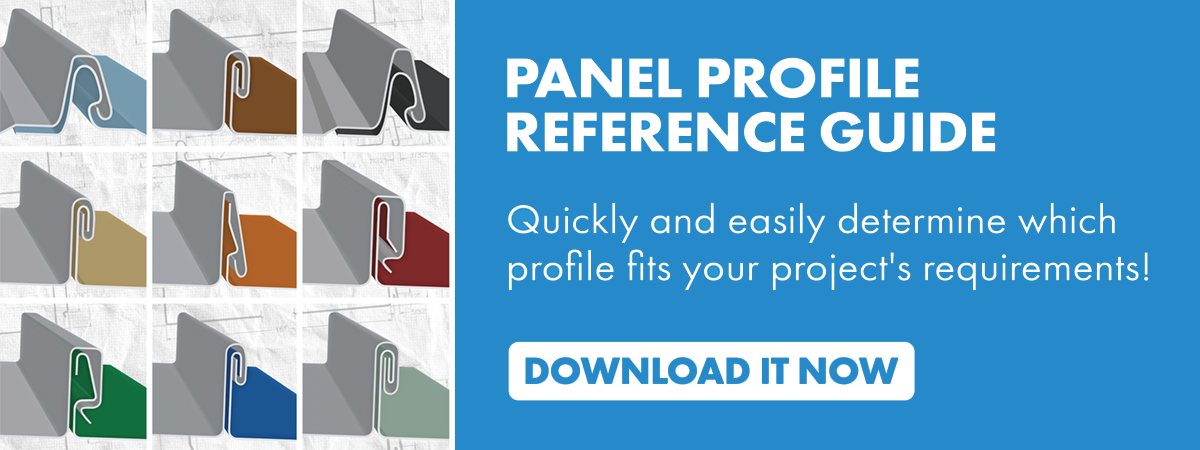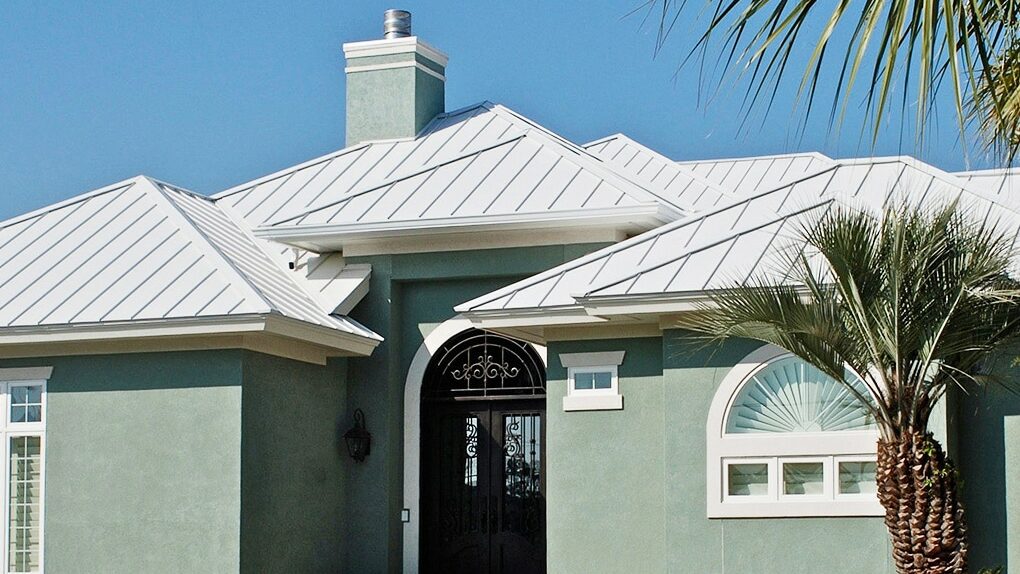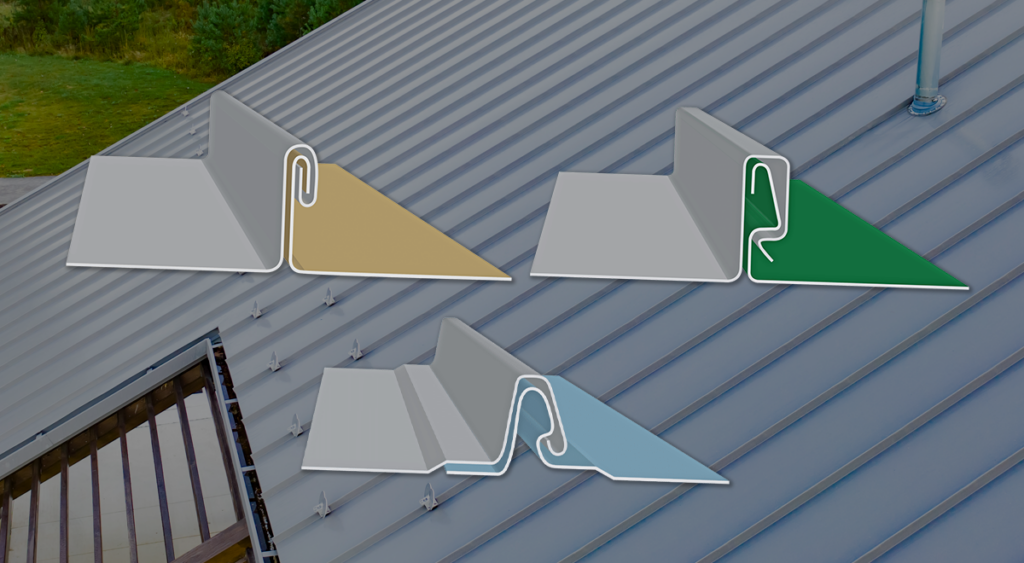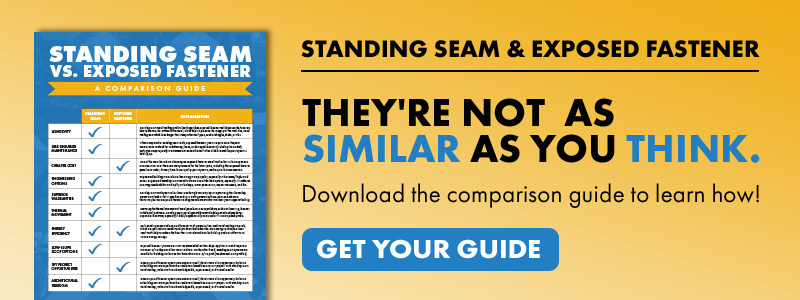On the outside, many standing seam metal roofing profiles look similar.
However, the different profile options — including mechanical seam, snap-lock, and nail strip/fastener flange — are distinctly different in terms of performance, engineering and testing, slope requirements, attachment method, price, and so on.
So, what are the differences between mechanical, snap-lock, and fastener flange, and how do the varied uses and features affect the one you should choose for your project?
At Sheffield Metals, we offer several engineered and non-engineered panel profile systems, including mechanical seam, snap-lock, and fastener flange/nail strip. Over the years, we’ve helped hundreds of contractors, homeowners, and beyond choose the profile that best fits their project’s specific requirements, so we think it’s important to share the notable differences.
In this article, we’ll go through:
- The uses, pros, and cons of mechanically seamed panel profiles.
- The uses, pros, and cons of snap-lock panel profiles.
- The uses, pros, and cons of nail strip panel profiles.
- Some example scenarios that could help you choose the best profile option.
Mechanical Seam Standing Seam Roofing Profiles

Mechanically seamed profiles are systems where the panel edges have vertical legs that line up, so the male leg goes down, then the clip goes over that leg and is fastened down. Then, the female leg of the panel goes over the clip to conceal it. These components are seamed together by a single or double lock:
- A single lock is ONE fold of the seam (or 90 degrees)
- A double lock is TWO folds of the seam (or 180 degrees)

Benefits/Advantages of Mechanical Seam Panel Profiles
Works for both low and steep-slope roofing applications – Mechanically seamed profiles are effective on both steep-slope and low-slope roof surfaces. While we don’t always recommend going below a 2/12 roof pitch for every project, there are low-slope scenarios and specific conditions where you can properly install a mechanically seamed profile. For example, depending on the design of your project and the location, the SMI 2.0” Mechanical Seam panel profile can be installed down to as low as a .5/12 roof slope in steel. Though, if you install this profile system below a 2/12 in steel, you must use continuous in-seam sealant to adhere to ASTM E 2140 standards and keep the seam as water-tight as possible.
Engineering & higher performance – Mechanically seamed profiles are some of the highest engineered standing seam panel profiles, as the mechanical seaming of the panels allows the roof to stand up to extreme weather events. For example, the SMI 2.0” Mechanical Seam panel profile has testing approvals for uplifts, air infiltration, wind-driven rain, water penetration, water submersion, impacts (hail), fire resistance, and foot traffic. Plus, it carries Florida Building Code (FBC) approval, Texas Department of Insurance (TDI) approval, and a UL 90 Construction Number. In other words, a mechanically seamed profile system is one of the best choices if you’re looking for a high-performance roof system.
Qualifies for commercial weathertight warranties – If your project is commercial, you’re likely already spending a significant amount of money on your new standing seam metal roof. That’s why we strongly recommend looking into protecting your investment with a weathertight warranty. Mechanically seamed profiles usually qualify for commercial weathertight warranties because they perform to high testing standards (always verify the profiles that are eligible for a weathertight warranty project).
Multiple locking options – There are two different locking options with mechanically seamed profiles: single and double lock. Because there are two folding options, it’s critical to know which is required with the engineering. Most of the time, it’s the double-lock 180-degree seam. Here’s a little bit more information about these two options:
- Single lock
- Single lock refers to ONE fold of the seam (or 90 degrees).
- Single lock still performs well in milder environments.
- Single locked systems require less labor, and replacing a damaged panel is easier than double lock profiles.
- Double lock
- Double lock systems are suitable for low-slope applications needing extra weathertightness.
- Double lock systems perform better than single lock, as panels are less likely to come unseamed.
- Double lock systems are suitable for properties in cold weather areas with freezing and thawing.
- Double lock panels are more labor-intensive to replace.

Allows for thermal movement of panels – Mechanically seamed profiles, especially double-locked profiles where an expansion clip is installed, are good choices in areas that experience temperature fluctuations. Many climates have dramatic temperature swings throughout the day, so it’s critical to allow for expansion and contraction of your system. Also, as snow/ice freezes and thaws, it expands and contracts the metal and panels, which could potentially disengage a snap-lock or fastener flange profile. Additionally, if you have roof panels over 25 feet, you should use clips that allow for thermal movement.
Some profiles approved for use over open framing – Very few standing seam profiles carry engineering when installed over open framing. However, some mechanically seamed profiles qualify, including the SMI 2.0 Mechanical Seam (engineering is only available for steel roofs that follow the specified engineering requirements for open framing applications).
Drawbacks/Disadvantages of Mechanical Seam Panel Profiles
More expensive standing seam option – There are a couple of reasons that mechanically seamed profiles are more costly than snap-lock and fastener flange profiles. Due to the seaming requirements for mechanically seam profiles, additional labor is often required. Plus, the seaming tends to take longer and can raise the price for the extended installation time required. In 2022, you can expect to pay anywhere from $7.50 to $17.00 per square foot for the installation of a mechanically seamed metal roof (price will vary depending on the roof complexity, deck assembly, accessories, and several other factors). Keep in mind that prices are continuing to fluctuate and could make the cost go up or down drastically.
More labor-intensive to install – As mentioned, mechanically-seamed profiles have to be seamed together using a robotic or hand seaming tool (most installers use robotic seamers, as they are easier to use and require less manual labor). These robotic seaming tools give the finished roof a much cleaner, more consistent look than hand seaming tools. However, no matter what device you use, it’s still a more tedious and time-consuming process than simply fastening the panels and snapping them together.
Not typical for DIY applications – There are some profiles that skilled DIYers can install, but mechanically seamed panels are usually not one of them. These profiles require a roofing professional to do the rollforming, installing, and seaming, which is often beyond the capabilities of most DIYers. And when it comes to something as critical as a roof, it’s often not worth the risk, as a roof failure can cause significant damage to a structure and property.
Snap-lock Standing Seam Roofing Profiles

Snap-lock panel profiles are concealed fastener systems where the male leg is attached to the roof deck by hidden clips and fasteners, and then the female leg snaps over the male leg. Snap-lock profiles don’t require hand or mechanical seaming during installation.
Benefits/Advantages of Snap-lock Panel Profiles
Engineered profiles available – One of the more significant benefits of a snap-lock metal roofing system is that they often carry engineering. Not all snap-locks are engineered, which will vary by manufacturer, but many are tested and proven to perform with numerous material types and roof deck substrates. Choosing an engineered panel profile ensures that you’re installing a system backed by actual data gathered by a third-party testing company and is rated following industry-wide standards. Many commercial structures must meet building codes, which could be fulfilled with an engineered snap-lock metal roofing system.
Commercial weathertight warranties available – Another benefit to installing a snap-lock metal roofing system is that some will qualify for commercial weathertight warranties. Most manufacturers that offer weathertight warranties can provide a listing of profiles that are approved for their weathertight warranties. A snap-lock system option can usually be used if the environment, slope, and other roof conditions are suitable for a snap-lock profile.
Less labor-intensive installation – With snap-lock profiles, panels have male and female legs that snap together after being rollformed, so no labor-intensive mechanical hand or robotic seaming is needed. Not having to seam the panels means it will take less time to install a snap-lock metal roof, especially when compared to a mechanical seam system.
Mid-level priced standing seam option – Compared to mechanical seam (most expensive) and fastener flange (least expensive), the price of a snap-lock standing seam roof runs somewhere in the middle. Snap-lock profiles require clips and fasteners to attach the roof to the deck, which will be more in material costs, but it doesn’t require the panels to be seamed, which will cut down on the labor costs. You can expect to pay anywhere from $6.00 to $14 per square foot for a snap-lock system in 2022.
Versatile and suited for multiple applications – Snap-lock profiles are frequently installed in residential, commercial, and architectural projects, which makes these profiles versatile and useful for more than just one application. This is also a benefit to a contractor or panel manufacturer because they can offer one profile (and only purchase one roller set for their rollforming machine) and use it for a broader range of projects.
DIY project friendly – While we always recommend using skilled metal roofing installers, some DIYers will be able to install a snap-lock metal roofing system because it’s a less labor-intensive installation. In the past, we’ve had DIYers purchase snap-lock panels from a distributor and successfully install them on their homes, sheds, accent pieces, and beyond. Keep in mind that the snaplock panels might be easy to install, but then you still have all of the difficult/complex trim details to contend with. That’s why we always recommend hiring a skilled metal roofing professional to install your critically important metal roofing structure.
Drawbacks/Disadvantages of Snap-lock Panel Profiles
Not recommended for roof slopes below 3/12 – In general, snap-lock profiles should not be used for roof pitches of 3/12 or lower. Snap-lock profiles are more intended for steep-slope applications because they are hydrokinetic systems, which means they must shed water quickly to remain water-tight. Flatter pitches don’t allow water to drain adequately, leading to premature degradation, color splotches/changes, and the overall failure of the roofing system. However, Sheffield Metals offers the SMI 1.5” Snaplock 550 and SMI 1.75” Snaplock profiles, which can be installed on slopes as low as 2/12 while adhering to ASTM E 1646 water penetration testing requirements.
Not recommended for open framing applications – Snap-lock profiles aren’t recommended for use over an open-framed roofing structure (without a solid roof deck). A mechanically seamed system would be better suited. If you’re unsure of the profile you should choose for your open framing project, it’s best to check with the manufacturer before the installation begins.
Creates a boxy, wider seam – Some snap-lock profile seams are sometimes considered too industrial or bulky because it has a broader, more box-shaped seam, which tends to be less of an appeal for residential applications.
Nail Strip / Fastener Flange Standing Seam Roofing Profiles

Nail flange (also called nail strip or fastener flange) attaches panels directly to the roof deck through the male leg or in the space between notches on the male leg. Once the male leg is fastened down, the female leg of the panel snaps over the entirety of the male leg to hide the fastener head.
While this sounds similar to other snap-lock profiles, fastener flanges are different. A true snap-lock profile is attached to the deck via clips that do not penetrate the metal’s surface. However, a fastener flange takes all clips out of the system and directly pins the panels to the decking structure.
Benefits/Advantages of Nail Strip Panel Profiles
Lower cost standing seam metal roofing option – Fastener flange profiles are the more economical standing seam metal roofing option. You can expect to pay anywhere from $5.00 to $11 per square foot for a fastener flange system in 2022. There are several reasons this profile type is cheaper:
- First, you don’t have to pay for the clips to attach the panels to the deck, which means there should be cost savings on materials.
- Second, this panel is easier to install and takes significantly less time to complete. It’s more efficient because the legs snap together after the panel is fastened down and don’t require any hand or robotic seaming to engage the panels.
Better suited for residential applications – Nail strip panel systems are more popular for residential properties, as they’re cheaper and don’t require strict building codes like commercial buildings. These profiles are still a good option for metal roofing on a home if you want to avoid an exposed fastener roof but don’t have the budget for a snap-lock or mechanically seamed system.
An option for DIY homeowners to install on their own roof – There are some metal roof systems that skilled DIYers can install — and a fastener flange system is often one of them. This profile requires a professional to rollform the panels, but a DIYer can install the system with some roofing knowledge. Like snap-lock profiles, we always recommend hiring a metal roofing contractor to install your roof, as many of the trim details are tricky without prior experience.

Drawbacks/Disadvantages of Nail Strip Panel Profiles
Roof performance is solely dependent on the fastener head – For nail flange systems, the roof is only held onto the building/structure by a fastener head and the engagement of the female leg. If the panel is exposed to the right force, the metal can rip away from the fastener head, loosen, or detach from the roof. Additionally, the panel system is only as strong as the engagement on the female leg, so if you use a thinner gauge metal, it will have a weaker engagement. If an extreme weather event comes through your region, you could be left with a damaged roof that will require fixing or even a complete replacement if bad enough.
Usually not engineered – Most fastener flange profiles are not engineered standing seam panel profiles. The specific engineering for a fastener flange system will depend on the profile’s manufacturer. Still, most aren’t tested to withstand uplifting, water penetration, air or water infiltration, wind-driven rain, foot traffic, and beyond. However, some carry other approvals; for example, the SMI 1.0” Fastener Flange SnapLock profile has a TDI approval and one UL 90 Construction Number but still doesn’t qualify as an engineered system.
Not recommended in extreme weather regions – Due to limited access to engineering and performance limitations, a nail strip profile isn’t suitable for residential or commercial structures in extreme weather regions. A fastener flange profile is likely not the best choice if you live in an area with threats of hurricanes, tornados, extreme heat, or significant snowfall/precipitation. Instead, you should look for an engineered profile that, at the very least, is uplift test approved.
Not suitable for low-slope applications – Nail strip profiles are only recommended for use on steep-slope/hydrokinetic roofing applications at or above a 3/12 pitch. If your roof slope is below 3/12 and you try to install a nail strip system, the slow-moving hydrostatic roof condition can cause water to get trapped in the panels, leak, and cause structural damage.
Follows imperfections of the roof deck – Since fastener flange panels are pinned to the roof deck without using clips, the panels will follow the shape of the deck and take on any of its imperfections. This can cause oil canning and, in severe cases, make it difficult for the panels to engage.
Limited length of panels – Due to the pinning and thermal movement concerns, most fastener flange profiles have a panel length limit of about 25 feet.
Mechanical Seam vs. Snap-Lock vs. Nail Strip: Which Should You Choose?

Scenario #1: You want/need an engineered metal roofing system.
- Best profile choice(s): Mechanical seam or snap-lock
Scenario #2: You want to purchase a commercial weathertight warranty.
- Best profile choice(s): Mechanical seam or snap-lock
Scenario #3: Your roof slope is below a 3/12 but above a .5/12.
- Best profile choice(s): Mechanical seam (double-lock)
Scenario #4: Your roof slope is 3/12 or above.
- Best profile choice(s): Mechanical seam, snap-lock, or fastener flange
Scenario #5: You’re a DIYer looking to install your own roofing structure.
- Best profile choice(s): Fastener flange or snap-lock (though we strongly recommend hiring a qualified roofing contractor for all metal roof installations)
Scenario #6: You’re in a region that experiences frequent freezing and thawing.
- Best profile choice(s): Mechanical seam or snap-lock
Scenario #7: You’re looking for the cheapest standing seam roofing option.
- Best profile choice(s): Fastener flange
Scenario #8: Your project is a commercial or larger residential application.
- Best profile choice(s): Mechanical seam or snap-lock
Scenario #9: Your roofing structure will be installed over open framing.
- Best profile choice(s): Mechanical seam
Scenario #10: You want an easier, less labor-intensive, or shorter installation.
- Best profile choice(s): Snap-lock or fastener flange

Final Thoughts on Mechanical Seam vs. Snap-lock vs. Fastener Flange
Mechanical seam, snap-lock, and nail strip panel profiles can all be utilized to build a durable, long-lasting, and aesthetically-pleasing standing seam metal roof. But which option is best for you is truly dependent on your project.
Remember that there are many size and style options for mechanical, snap-lock, and nail strip profiles, as well as other metal roof options beyond the ones we’ve covered today (a full listing of our profiles can be found here). However, these are the most common concealed fastener systems. So, if you consider all of the uses, pros, and cons we outlined above, you’ll be on the path to choosing the best concealed fastener profile.
For over 25 years, Sheffield Metals has provided our customers with the materials, instructions, details, and support on all metal roofing and wall system projects. That’s why we offer a variety of standing seam panel profiles for nearly every application, whether your project is commercial, architectural, residential, structural, or beyond.
To inquire about any of our panel profiles — mechanical seam, snap-lock, fastener flange, or otherwise — please contact one of our experienced technical representatives today!
